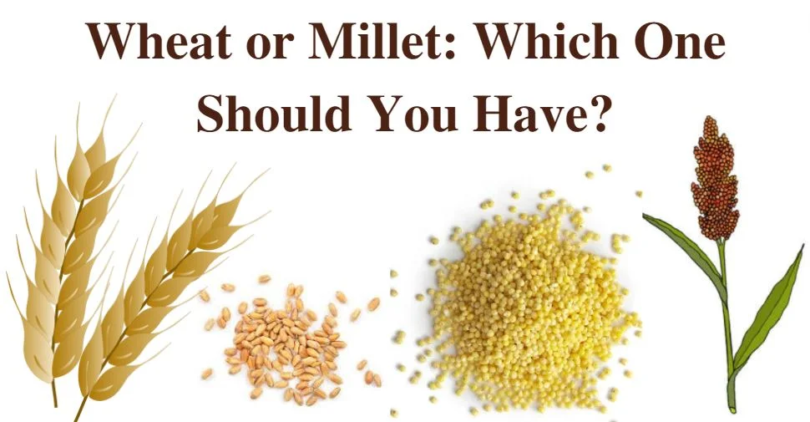Wheat or Millet: Which One Should You Have?
Going gluten-free is something you may want to consider. Also, adopting gluten-free might just be the newest diet trend, so you must first gain a thorough understanding of it. Therefore, in this piece, we will compare millets and wheat to see which one you should choose. Keep on reading.
What Is Millet?
Millet is a cereal grain in the Poaceae family, which is also known as the grass family. Millets are small seed grasses and cereal crops that are commonly used in African and Asian countries. When compared to wheat, rice, and some other cereal grains, they provide far more fiber and important minerals.
Types Of millet-
Sorghum (Jowar)
In India, sorghum is referred to as Jowar. It is one of the most prominent and well-researched millet for weight loss. Jowar is high in iron, protein, and fiber, and it contains a component called policosanols, which can help lower cholesterol levels. Wheat intolerance sufferers will benefit from it.
Finger Millet (Ragi)
Ragi or Finger Millet is a popular millet that is often consumed. Ragi can be used as a substitute for rice and wheat due to its high nutritional value. This gluten-free millet, which is high in protein and amino acids, is beneficial to children’s brain development. It is highly helpful in maintaining blood glucose levels and hence has a significant impact on patients with diabetes.
Foxtail Millet (Korra)
Foxtail Millet is high in Vitamin B12, which is important for heart health, nerve function, and skin and hair growth. Iron and calcium are included in this millet, which assists to boost immunity. In Type-2 diabetes patients, a diet rich in Foxtail Millet can help them achieve better glycemic control and lower insulin, cholesterol, and fasting glucose levels.
Pearl Millet (Bajra)
Bajra, also known as Pearl Millet, has an iron content that is eight times higher than rice. Consumption of pearl millet aids in the relief of constipation and other digestive ailments. It assists in the effective production of milk and stimulates lactation. This millet is packed with iron, protein, fiber, and minerals like calcium and magnesium, so eating it on a regular basis or including it in your diet can do miracles.
Barnyard Millet (Sanwa)
A nutritious millet contains a high amount of fiber, which can assist with weight loss. It is high in calcium and phosphorus, which promotes bone formation and helps prevent bone illnesses when consumed on a regular basis. Millets are nutrient-dense, non-glutinous, and acid-free, making it extremely trouble-free to digest. Constipation, excess gas, bloating, and cramps are all alleviated by the high fiber content.
Proso Millet (Chena)
Proso Millet is also high in protein and has a low glycemic index. This millet can help you maintain a healthy blood sugar level. It’s abundant in antioxidants and minerals including magnesium, potassium, and phosphorous, and it can help prevent osteoporosis. It’s a popular bird food in India.
Little Millet (Sama)
Little millet is high in magnesium, which is good for the heart. Little millets, which are high in B-vitamins and minerals like calcium, iron, zinc, and potassium, can give critical nutrients that aid in weight loss. Little millet is high in phosphorus, which assists fat metabolism, body tissue repair, and energy production. Furthermore, it is a nutritious substitute for rice due to its high fiber content.
What Is Wheat?
In terms of nutritional content and health, wheat is one of the most adaptable grains. Wheat is a cereal crop that is both old and vital. Wheat is classified into two categories. Triticum aestivum vulgare, is the most common type of wheat. The other type of wheat is durum wheat or Triticum turgidum durum. It is quite easy to integrate into your everyday diet and can be obtained all around the world. It is a worldwide staple meal that is ground making flour, bread, pasta, and pastry. Wheat is high in a variety of nutrients that are beneficial to your health. This is an excellent basis for almost any diet since it incorporates catalytic elements, Vitamin E, Vitamin B, mineral salts, copper, calcium, iodide, magnesium, zinc, potassium, manganese, sulphur, silicon, chlorine, and arsenic.
Wheat Vs. Millet- Which One You Should Eat?
As we earlier understood, what exactly are millet and wheat? Now let’s understand the millet vs wheat and which one you should consume. Millet is relatively similar to wheat in terms of total calories, carbs, and fats. But they contain somewhat more protein than wheat. The quality and amount of micronutrients in them, particularly Vitamin B complex, iron, calcium, and several other minerals, stands out.
Millets are also high in fiber, and the manner the fiber is structured in such millets is incredible and one-of-a-kind. The fiber structure within those five millets is woven in concentric circles with carbs from the grain’s center to the outside layer. As a result, it delivers glucose into the bloodstream in a controllable and consistent manner while digestion. With wheat and rice, this is not the case. It can assist with gastrointestinal issues as well as other liver and kidney illnesses.
Wheat is quickly digested, resulting in increased insulin secretion and weight gain. Millets cause you to eat more slowly and ingest less because of their high fiber content. Millets also use less water and chemicals than rice and wheat, which helps to protect and preserve the environment.
Wheat contains a lot of oxalates, and that is why you should never ever eat too much of it. Kidney stones, gallstones, and gout can all be caused by having too many oxalates in your blood. Millet is high in complex carbohydrates and fiber. Millet has a low glycemic index, is naturally gluten-free, alkaline, and has much other healing potential, and therefore does not put a load on our bodies but instead assists in their healing.
Millets are good for lowering cholesterol. Millets reduce low-density lipoprotein cholesterol (commonly known as bad cholesterol) while increasing high-density lipoprotein cholesterol (the good cholesterol). They also help prevent heart disease and assist to avoid a variety of cardiovascular disorders. Millets are high in micronutrients, iron, magnesium, zinc, calcium, manganese, and many more. They can also make a whole healthy meal when combined with a range of seasonal and local veggies. As a result, they are an excellent supplement to anyone’s diet.
Millets can be an excellent anti-inflammatory component to a diet when used instead of wheat. They are non-glutinous, which makes them far more manageable for people who suffer from chronic illnesses. They contain far more protein than other cereals.






